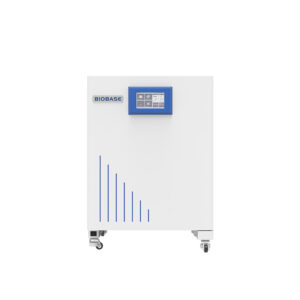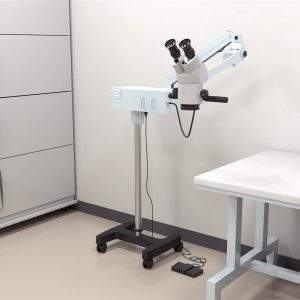$790.00
The Series Polarizing Microscope with Halogen Lamp uses reflected and transmitted light to observe birefringent materials such as rocks and polymers. The halogen lamp is used as a light source, and a pair of polarizing filters produce polarized light.
The microscope is equipped with an eyepiece, eyepiece tube, blue and frosted filters, polarizer, and collector. It supports both binocular and trinocular heads that can be inclined at 30°. It comes with 4 achromatic objective lenses with different magnifications. In addition, it has a quadruple nosepiece sliding polarizing analyzer, 120 mm rotatable, and double layer mechanical stage with 75mm×35mm moving range which helps not only in moving the stage in a vertical direction but also along the horizontal axes. The coaxial coarse and fine focus system includes a minimum division of fine focusing up to 2 microns. An Abbe condenser is used to focus the light onto the specimen. Furthermore, a 6V 20W halogen lamp and a polarizer are used to illuminate the sample.
ConductScience offers the Polarizing Microscope with Halogen Lamp.

Experts in Manufacturing and Exporting Optical Instruments, Microscopes and more other Products.



Model | POL1100 | POL1100A |
|---|---|---|
| Eyepiece | WF 10X (Φ18mm) | WF 10X (Φ18mm) |
| Eyepiece Tube | Binocular, inclined 30° | Trinocular, inclined 30° |
| Objective | Achromatic objectives 4X/0.10 Achromatic objectives 10X/0.25 Achromatic objectives 40X/0.65 (Spring) Achromatic objectives 100X/1.25(Spring, oil) | Achromatic objectives 4X/0.10 Achromatic objectives 10X/0.25 Achromatic objectives 40X/0.65 (Spring) Achromatic objectives 100X/1.25(Spring, oil) |
| Nosepiece | Quadruple (Backward ball bearing inner locating) | Quadruple (Backward ball bearing inner locating) |
| Polarization Analyzer | Sliding | Sliding |
| Stage | Rotatable stage(Diameter: 120mm) | Double-layer mechanical stage with (100mm) rotatable stage (Size:135mmX125mm Moving range:75mmX35mm) |
| Focus System | Coaxial coarse/fine focus system, with tension adjustable and up stop, minimum division of fine focusing is 2.0μm | Coaxial coarse/fine focus system, with tension adjustable and up stop, minimum division of fine focusing is 2.0μm |
| Abbe Condenser | NA.1.25 Rack & pinion adjustable | NA.1.25 Rack & pinion adjustable |
| Filter | Blue, Frosted | Blue, Frosted |
| Polarizer | 360° rotatable stage | 360° rotatable stage |
| Collector | For illumination with halogen lamp With field diaphragm | For illumination with halogen lamp With field diaphragm |
| Illumination Unit | With a polarizer, 6V 20w, halogen lamp, adjustable brightness | With a polarizer, 6V 20w, halogen lamp, adjustable brightness |
Documentation
The Series Polarizing Microscope with Halogen Lamp uses reflected and transmitted light to observe birefringent materials such as rocks and polymers. The halogen lamp is used as a light source, and a pair of polarizing filters produce polarized light. The polarizer is placed before the specimen, and the analyzer (a second polarizer) is fixed perpendicularly to the first polarizer.
The microscope is equipped with an eyepiece, eyepiece tube, blue and frosted filters, polarizer, and collector. It supports both binocular and trinocular heads that can be inclined at 30°. It comes with 4 achromatic objective lenses with different magnifications. In addition, it has a quadruple nosepiece sliding polarizing analyzer, 120 mm rotatable, and double layer mechanical stage with 75mm×35mm moving range which helps not only in moving the stage in a vertical direction but also along the horizontal axes. The coaxial coarse and fine focus system includes a minimum division of fine focusing up to 2 microns. An Abbe condenser is used to focus the light onto the specimen. Furthermore, a 6V 20W halogen lamp and a polarizer are used to illuminate the sample.
A pair of polarizers are used to produce the polarized plane light. The light coming from the halogen lamp passes through the first polarizer placed before the sample. Then it goes through the second polarizer known as an analyzer placed perpendicularly to it. The analyzer combines the different rays emerging from the specimen and produces the final images.
The Series Polarizing Microscope with Halogen Lamp is used from basic imaging of pharmacological ingredients to morphology and optical crystallography. Böhme, Morales-Rivas, Diederichs, & Kerscher (2018) used a polarized microscope to study coarse structures having intrinsic optical anisotropic properties.
The series polarizing microscope is used in the processes of the homogenization of sugars, salt, flour, and developing photographic powders. It is also used in chemical preparations, precipitates, and the detection of adulterants and contaminants. Moreover, the polarizing microscope has just entered the dyes industry, where its usage is being considered for partly managing the manufacturing processes of intermediates and end products.
One of the most impressive uses of this microscope is the depiction of mineral development textures, alteration, and other internal textures that are not detectable by conventional analytical methods. With these findings, scientists can re-create the geological processes that led to mineral creation and subsequent modification in miniature.
Other uses of the microscope include studying unstained mammalian birefringent cochlear sections, which was conducted by researchers Kalwani et al. (2013).
A plethora of aspects of the various birefringent materials may be studied using the Series polarizing microscope with halogen lamp, such as refractive indices, isotropic/birefringent characteristics, extinction, dichroic/polychroism opaqueness, and reflected light hues. Polarized light microscopy is a valuable technique for generating contrast in birefringent specimens and determining the characteristics of crystallographic axes in diverse materials.
Proper alignment of optical parts demands a skilled person. Another limitation of this microscope is that it can only be used to study anisotropic materials.
| Brand | Suzhou Jingtong Instrument Co. |
|---|---|
| eyepiece | |
| filter | |
| objective | Achromatic 100X /1.25(Spring, Oil), Achromatic 10X /0.25, Achromatic 40X/0.65(Spring), Achromatic 4X /0.10 |
You must be logged in to post a review.
There are no questions yet. Be the first to ask a question about this product.
Monday – Friday
9 AM – 5 PM EST
DISCLAIMER: ConductScience and affiliate products are NOT designed for human consumption, testing, or clinical utilization. They are designed for pre-clinical utilization only. Customers purchasing apparatus for the purposes of scientific research or veterinary care affirm adherence to applicable regulatory bodies for the country in which their research or care is conducted.
Reviews
There are no reviews yet.